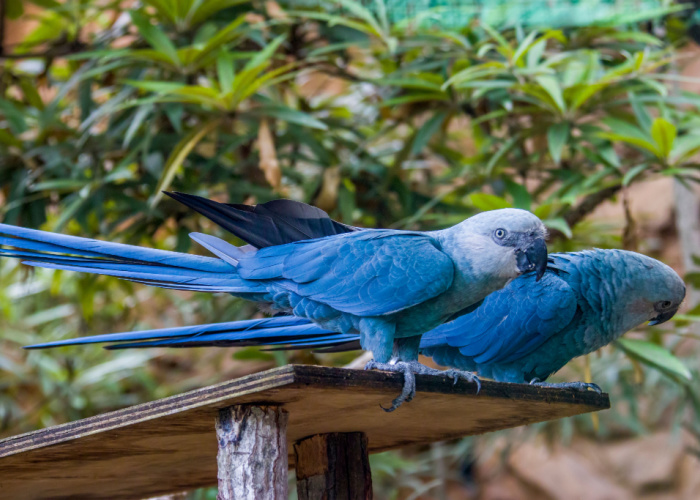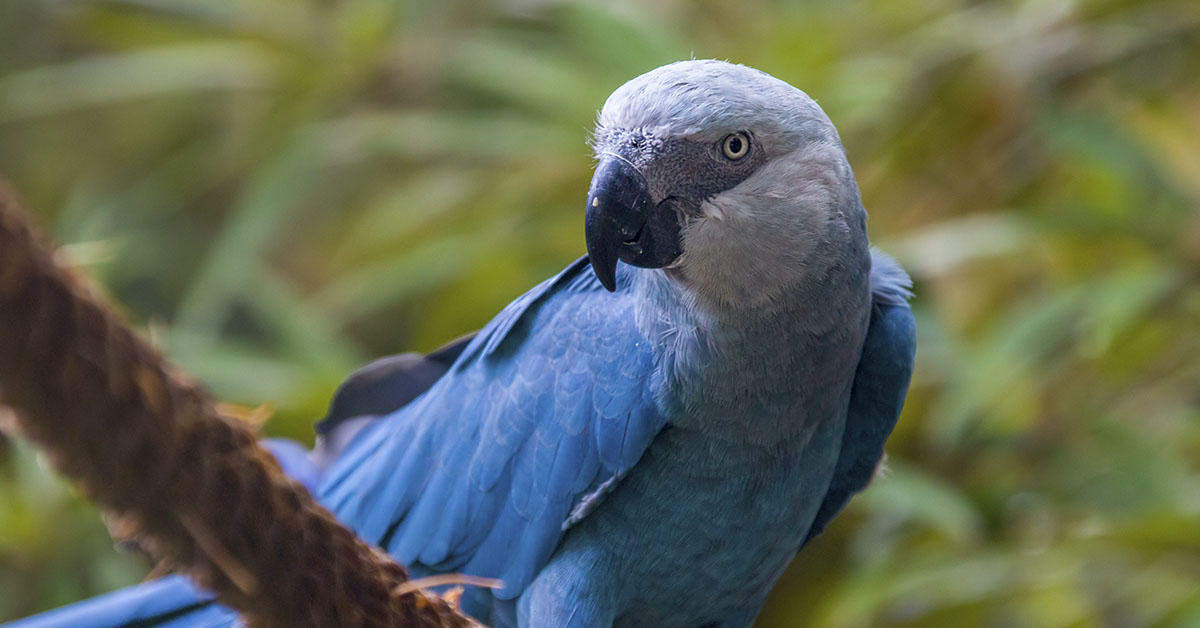Twenty-two years ago, the Spix’s blue macaws disappeared from nature. They were extinct, aside from those in captivity. Conservationists and scientists endeavored to save these rare, mythical-looking parrots and seemingly succeeded. This summer, eight blue macaws were released into a protected natural reserve in Brazil, back into their natural habitat. “They’re doing absolutely wonderful,” said biologist Tom White. “So far there is 100 percent survival. The birds are all staying together as a group… They’re staying in around the release area. And they’re also beginning to forage on natural occurring foods. We couldn’t have written a script better for them to follow.” [1]
The “Extinct” Spix’s Macaws Fly Home
The return of the Spix’s macaws was made possible with advances in captive breeding and artificial insemination. According to White, a technical advisor for the project as well as part of the U.S. Fish and Wildlife Service, the team used DNA testing to pair up birds that were the least related to each other.
The released Spix’s macaws’ new home is in the caatinga, a subtropical dry forest in Brazil. Over the last century, the natural habitat was destroyed for ranching and farming, which contributed to the birds’ almost extinction. At the same time, people who collected exotic birds hunted the Spix’s macaws to keep as pets. They were treated like a status symbol with collectors paying tens of thousands of dollars for one bird. In 1987, only three remained in the wild, but by the end of the year, poachers took two of them.

As a result, there was only one left in the wild in the mid-1990s. Scientists tried to continue the species with the last wild blue macaw. They tested its stray feathers to find out it was male, so they released a single female from captivity, hoping they would mate. At first, all seemed well. After two months, the two finally paired up. But two weeks later the female was found dead under a power line. The last wild male disappeared a few years later, last spotted in 2000.
Read: The Gruesome Truth Behind The Chicken Who Lived Without A Head For 18 Months
The Reintroduction Project
Awareness for the dwindling species heightened after the animated film Rio in 2011. But the International Union for Conservation of Nature called the species extinct in 2019. However, the birds weren’t completely wiped out. Many remained in captivity. So German businessman and parrot collector Martin Guth began the Association for the Conservation of Threatened Parrots (ACTP) with the mission to bring the Spix’s macaws back to the caatinga. He is not the first to breed Spix’s macaws in captivity and then introduce them to the wild. In fact, other owners tried the same, which resulted in controversies over involvement and credit. But the ACTP along with the Pairi Daiza Foundation and the government of Brazil succeeded in breeding 180 Spix’s macaws in captivity with the eight released into the protected reserve. [2]
Read: Dozens of Giant Coconut Crabs Crash Family’s Quiet Picnic to Steal their Food
Keep in mind, that there are very few reintroduction programs bringing species back into nature, and none have tried parrots before. In fact, very few bird reintroductions have been successful, according to George Amato, a conservation biologist at the American Museum of Natural History. But the team had to try. “I hope it works, because we really have no other alternatives,” Amato said. [3]
The eight Spix’s macaws were released with eight of the more common Illiger’s macaws, which were captured only briefly. The two kinds of macaws lead similar lifestyles on the caatinga. The researchers hope the Illiger’s macaws will help the Spix’s join the flock of Illiger’s in the wild, where they can teach them how to navigate, find food, and avoid predators. Plus, macaws are highly social species and they must live in a group to establish a population. “We can actually increase the flock size without extra Spix’s …while using a native species which knows the habitat, knows the area, that can function as mentors,” said White.
“So far things are going well”
Although eight Spix’s macaws have returned to the wild, the work is not over. “It’s not a matter of going out and just releasing a bunch of birds and then opening a bottle of champagne, calling it a day. It takes continual effort over several years, and that requires long-term financial, logistic and biological support,” said White. But if all goes well, twelve more Spix’s macaws will join the flock in December, and more should follow. These birds will hopefully lead the species back into its place in the ecosystem. But if there are too many losses, the researchers might have to round up the rare birds again to keep them safe.
“These birds will all be of reproductive age,” said White about the potential twelve new macaws. “We have also ensured there are several nest cavities, some natural and artificial, in the area to encourage the birds to begin mating next year and eventually establish breeding territories in the area. It’s ambitious but so far things are going well.” [4]
Keep Reading: World’s oldest known wild bird has another chick at age of 70
Sources
- “This beautiful blue parrot has returned to the wild 2 years after being declared extinct.” CBC News. August 9, 2022
- “Back from the brink of extinction: The Spix’s macaws are returning to the wild.” Euro News. Doloresz Katanich. June 3, 2022
- “A Wild Hopes.” Science. Kai Kupferschmidt. June 9, 2022
- “‘Extinct’ parrots make a flying comeback in Brazil.” The Guardian. Robin McKie. July 10, 2022

